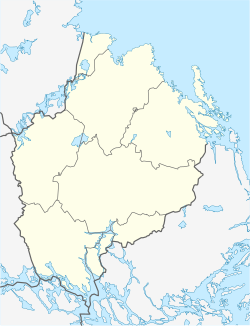Lövstabruk
| Lövstabruk | |
|---|---|
 |
|
| Coordinates: 60°24′N 17°53′E / 60.400°N 17.883°ECoordinates: 60°24′N 17°53′E / 60.400°N 17.883°E | |
| Country | Sweden |
| Province | Uppland |
| County | Uppsala County |
| Municipality | Tierp Municipality |
| Area | |
| • Total | 0.20 km2 (0.08 sq mi) |
| Population (2010-12-31) | |
| • Total | 96 |
| • Density | 472/km2 (1,220/sq mi) |
| Time zone | CET (UTC+1) |
| • Summer (DST) | CEST (UTC+2) |
Lövstabruk is a village on a common in the parish of Österlövsta, Tierp Municipality, Uppsala County, Sweden. In 2010 it had a population of 96, compared to some 1300 at its height during the 18th century. The word lövsta is derived from lösta, an old Swedish word for "glade". The contemporary spelling in the 18th century was Leufsta, with French orthography reflecting the Walloon origin of the workforce. The latter part of the name, bruk, means both "mill town" and "ironworks".
The settlement was founded as an ironworks by local farmers during the 16th century, from then on relying primarily upon the quality Dannemora ore. The ownership changed hands to the crown and back again. Another forgery was later built by the crown, which from time to time was leased to various tenants, most notably , governmental inspector over most ironworks in Sweden, in 1626 and to him and his partner Louis De Geer in the succeeding year. They introduced Walloon forging here, with at most five pairs of hearths (finery and cafery). In 1641 Louis de Geer, by then Swedish citizen, purchased Lövstabruk from the crown as part of a land sale to relieve the government's shortage of cash, and in 1668 his son Emanuel was able to negotiate a purchase of the other forge from the farmers. During his time, the facility was expanded considerably, and a park was created along the swamped sides of Risforsån, the creek from which power was supplied in four waterfalls, in total falling over 15 meters. Due to a shortage of charcoal, the blast furnaces were relocated to neighbouring villages, where various other expansion also took place. However, Lövstabruk remained the main production facility, and was the biggest ironworks in the country during a number of years in the 18th century. The iron produced at Leusta was of a kind known in England as oregrounds iron, after the port town of Öregrund. The brand mark used at Leufsta was an 'L' inscribed in an open circle, so that its products were known in England as "Hoop L iron". It was classified as first oregrounds and at the height of its power most of the products were exported to England, where it was converted to blister steel by the cementation process.
...
Wikipedia


